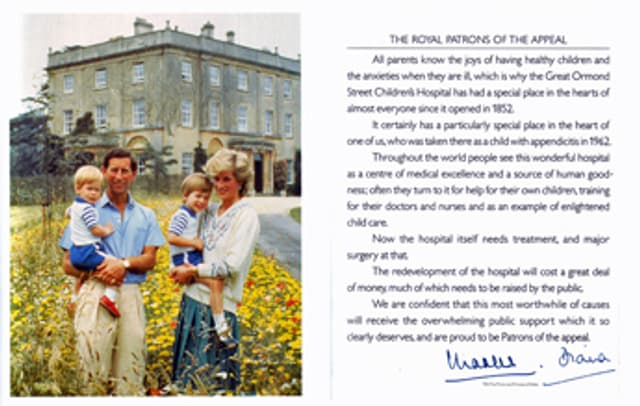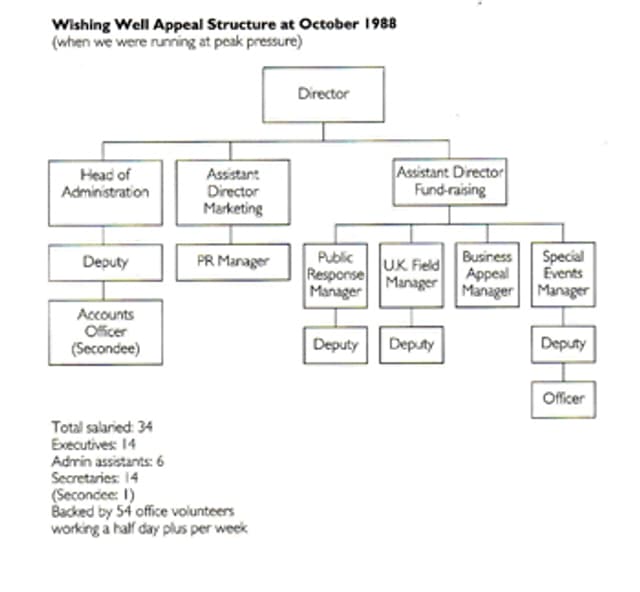The Wishing Well Appeal for Great Ormond Street Children’s Hospital
- Exhibited by
- Marion Allford
- Added
- October 28, 2010
- Medium of Communication
- Broadcast and television, face to face, posters, press advertising
- Target Audience
- Individuals, major gift, planned gift, regular gift, single gift, corporations, granting organisations
- Type of Charity
- Children, youth and family, healthcare
- Country of Origin
- UK
- Date of first appearance
- October, 1987
SOFII’s view
It's difficult to do justice to a capital campaign as wide, complex, ambitious and successful as the Wishing Well Appeal for the world famous Great Ormond Street Children's Hospital. The best we can aspire to is to give readers a taste of the different aspects of the appeal and to direct all further interest towards Marion Allford's comprehensive account of the campaign, which she describes in her book 'Charity Appeals: The Complete Guide to Success'. What follows is a condensed summary of a major capital campaign which, at the time, was the largest appeal ever mounted in the UK and certainly one of the most successful. All who were part of it shared an exceptional emotional experience and a justly deserved sense of achievement. The lessons for today's fundraisers are legion.
NB: There are many aspects to this story, so to try to give you the detail you might need we've prepared five more linked pages, including an informative two-part article from the director of the appeal which, when read in conjunction with this exhibit, will give you a complete picture of the campaign. See below for links.
Creator / originator
Marion Allford led the professional and volunteer team. She was appointed because she had a successful track record in setting up and running multi-million pound appeals and came originally from a public relations and marketing background with 'blue chip' UK companies.
There was no fundraising structure in place before the Wishing Well Appeal, so it had to be set up from scratch. The director aimed to use minimum staff, backed by suitably qualified volunteers, before the money started to flow. At the height of the Wishing Well Appeal, there were up to 100 office volunteers, working in rotas, manning six telephone lines in a very inadequate basement. They were magnificent.
This exhibit has several parts.
Marion Allford's articles
&
Summary / objectives
The Great Ormond Street Children's Hospital (GOSH) is justly famous the world over for innovative patient care and advanced research, which has developed some of the most progressive and effective treatments and procedures in patient treatment and care, especially for young children. At the time of this appeal (see below for current figures) the hospital was treating 9,000 in-patients and 60,000 out-patients annually. Most of these were very sick children referred to the hospital from around the world, because the combination of specialised expertise that they needed would not be available locally.
'My wife and I have shared with other Great Ormond Street parents that curious mixture of alarm and dismay, combined with relief on being told that your child is being referred to Great Ormond Street. Your precious child, needing to go to what is the most famous children's hospital in the world. Dismayed because you are under no illusion, it is serious, it's very serious and the case needs the very best care that is possible. And then the relief: the relief that your child will have the very best care that there is.'
Television presenter Jonathan Dimbleby on what it means to be a Great Ormond Street parent.
Despite its fame and many achievements, in 1987 the hospital was in urgent need of extensive redevelopment. At that time the total cost of ensuring that this internationally acclaimed facility would be properly housed and equipped was estimated to be £72 million (around US$110 million). Of this huge sum, £30 million was guaranteed by the UK government provided that the hospital itself raised the remaining £42 million. The task of raising this vast sum fell to a carefully constructed team of professional fundraisers and volunteers established and led by seasoned architect of large capital appeal campaigns, Marion Allford.
At the start of the appeal, the future of the Great Ormond Street Hospital (GOSH) was in jeopardy because of outdated and inadequate buildings and facilities. The hospital was then housed in old, even obsolescent buildings, built long ago when concepts of patient care were vastly different from what they are today. New operating and recovery rooms were needed, as were post-operative recovery areas, intensive care units, rooms for seminars and play areas. GOSH was one of the pioneers of the concept of total family care, which allows family members to stay with the sick child throughout the treatment. Yet there was no parent accommodation and at any one time up to 150 parents had to sleep each night wherever they could find a space.
The objective of this appeal was nothing less than to secure the survival and continuance of what is arguably the world's finest children's hospital.
'At one extreme was our surprise and delight at receiving, through the post, five pence (about US8¢) sent by a five-year-old to “Great Ormond love Sarah". At the other was a nice letter of response enclosing a cheque for £3 million, with no strings attached. And it wasn't even April 1st!'
Marion Allford, Director of the Wishing Well Appeal
Background
'Even appeals for such emotive causes as children's hospitals have been known to fail by using the wrong strategy – or no strategy.' So says Marion Allford in the two accompanying articles which describe in detail the overall fundraising strategy. Click here to see or follow the links above. In these articles Marion outlines the seven key factors in ensuring success of an appeal and describes in detail the four main parts of a classic capital appeal, then goes on to share her reflections 20 years later on this remarkable and instructive campaign.
Special characteristics
This was at the time the largest ever appeal of its kind in the UK. It is still – 20 years later – the largest capital appeal achieved for a UK hospital.
Influence / impact
It is impossible to overestimate the huge impact that this appeal, along with another great appeal of the time the NSPCC's Centenary Appeal in 1984, had on the conduct of capital campaigns in the United Kingdom and elsewhere. It became the blueprint that others followed and its influence is felt still.
Costs
The policy of the Wishing Well Appeal was to keep costs to a minimum and to attract pro bono assistance and gifts in kind wherever possible.
A general rule of thumb is that it is seen as respectable for big gift fundraising to have a cost-to-income ratio of about 10 per cent, whilst public phase fundraising is much more expensive – nearer 25 to 30 per cent. Because of the massive public response, the Wishing Well Appeal was able to keep its costs to approximately two per cent of the funds raised.
Results
A total of £54 million was raised by the appeal, £12 million ahead of the target, which at the outset had seemed so impossibly huge. In addition, raising the £30m from the government was an achievement of the appeal too. Before the appeal structure was in place, the hospital had been told that there would be no statutory funding for the redevelopment.
Merits
This is a campaign of historic significance, not just because of the scale of its achievements but because of the range of professional techniques that were used. Also, a complex, carefully assembled team of amateurs and professionals came together behind a common objective, to dramatically exceed their already ambitious target.
Apart from responding to the emotiveness of the appeal, this business-like and imaginative approach to the setting up and management of the appeal was picked up and written about extensively by the press. It even led to a television programme about using business methods to benefit charity.
The appeal's outstanding success is all the more remarkable because it was launched to the public one week after 'Black Monday' on 19 October 1987, when the world experienced the largest one-day percentage decline in stock market history.
But what was so special?
Yes, it was a very big appeal, the biggest at its time. But it was special because there was no fundraising machinery at GOSH before this appeal, it was set up from scratch and completed in four years. The other big appeals were pulled off by large, on-going fundraising charities with well-established fundraising infrastructures.
Other relevant information
The three most important components of any appeal are the cause, the leadership and the overall strategy.
In this appeal the cause was about as emotive and compelling as you could have: sick children. The Wishing Well Appeal was enormously well connected, which helped every aspect of the appeal no end. The leadership was, as normal, vested in the charity's trustees, but here a special appeal committee was set up under the chairmanship of former government minister Lord James Prior.
The Royal Patrons of the appeal were their Royal Highnesses The Prince and Princess of Wales.
Final notes
Some key current GOSH statistics
Number of patients: Over 200,000 patient visits (inpatient admissions or outpatient appointments) a year.
Number of staff: Around 3,280 hospital staff. The Institute of Child Health has around 470 staff. (Many senior staff have roles in both organisations.)
Beds:
- 387 beds for all our services. 447 beds on the central London site. (Note 1). There are 25 beds and 18 special care baby unit cots at the North Middlesex site.
- 49 of these are intensive care beds (46 at central site, three intensive care special care baby cots at North Middlesex).
- 63 per cent of our specialist inpatients would count as 'intensive care' or 'high dependency' patients in another hospital, showing what heavy levels of nursing they require.
Note 1: this figure does not include the 38 beds in the patient hotel. These patients are not under the care of a nurse and therefore these beds are not beds in the NHS sense of the word. The hotel can take 30 families short term (up to a week) and eight families for lengthy periods.
Services: The hospital website lists 55 clinical, diagnostic and support services.
Core claims and figures
The top 'biggests and bests':
- Largest centre for research into childhood illness outside the USA (1,300 research papers published a year).
- Largest centre for children with heart problems in the UK and largest centre for children's heart transplants in the world.
- Largest centre for children needing brain surgery in the UK – for example, the largest epilepsy surgery centre in Europe.
- With the University College London Hospitals (UCLH) we are the third largest centre for children with cancer/leukaemia in the western world and the largest in Europe. We take patients from 0-11 years old, UCLH also take 12 plus.
- Largest centre for children with kidney problems in UK. In fact one in 10 of our patients need renal assessment or help.
- Largest centre for children with HIV or haemophilia in UK.
- Largest single trainer of paediatric nurses in UK (with London South Bank University).
- Largest range of children's specialists in one institution in the UK.
- Largest centre for children's craniofacial surgery and head injury in the UK.
- Largest intensive care unit for children in the UK.
- The country's only specialist biomedical research centre for paediatrics.
Some 'breakthroughs':
- The hospital has done more than 370 heart, heart and lung, and lung transplants since the transplant programme began.
- Pioneering work on non-surgical replacement of pulmonary heart valves, over 216 cases done. Leading role in cardiology developing alternatives to surgery.
- Only tracheal service in Europe. A unique team operates successfully on children with very narrow windpipes – smaller than the tube in a biro.
- Over 1200 bone marrow transplants. Breakthroughs include less intensive transplants for very sick children.
- Successful gene therapy – treating children by implanting an artificial gene in their failing immune system. Successes in two diseases and planned trials in a number of others. Leading centre in the world for gene therapy in children.
- For hyperinsulinism, where children produce too much insulin, we can remove most of their pancreas through keyhole surgery. For many of these patients we can remove the faulty parts only, therefore, reducing the chance that they will get diabetes.
- Leading centre in Europe for the management of conjoined twins (so-called, Siamese twins): high complex imaging problem, complex surgery and then complex management thereafter.
One of the best legacies of the Wishing Well Appeal was a very successful ongoing fundraising operation, as the hospital still relies heavily on its charitable funding, which as a priority is seeking funds to redevelop the rest of the hospital site.
Additional information
Click here to view a short film introducing the Wishing Well appeal, presented by appeal chairman Lord James Prior.
Other relevant documents
BROADSWORD – an aid for all capital appeals.
There's a lot of preparatory homework to be done before the first volunteer is recruited, the first donor identified and the first pound is raised. Before embarking upon a capital appeal any fundraising organisation has to ask itself a number of crucial questions. These are set out in detail in the BROADSWORD list which can be downloaded by following this link. This list comes from Marion Allford's book Charity Appeals.
Copies of Marion Allford's book Charity Appeals: The Complete Guide to Success, published in 1992 by J M Dent and Sons in association with the Institute of Fundraising, can be obtained directly from Marion Allford Associates.
Marion Allford's articles
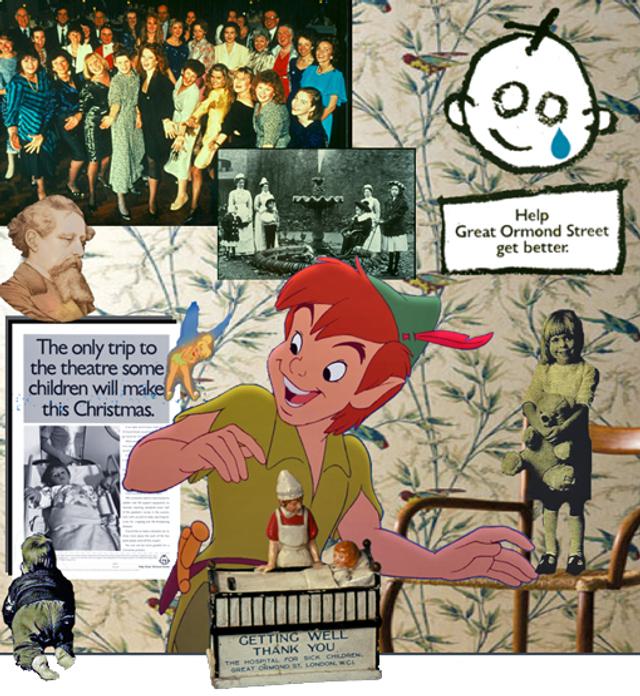
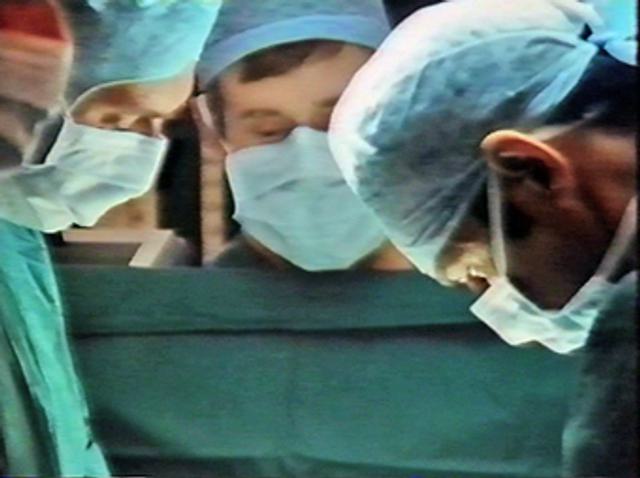
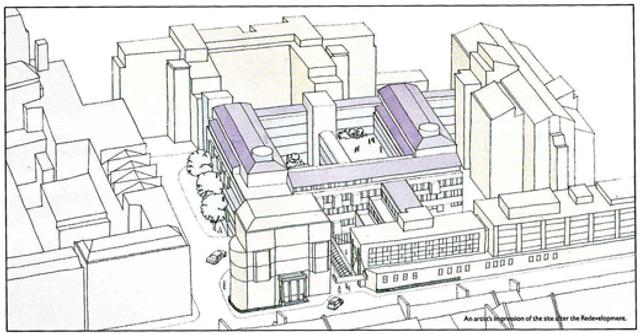
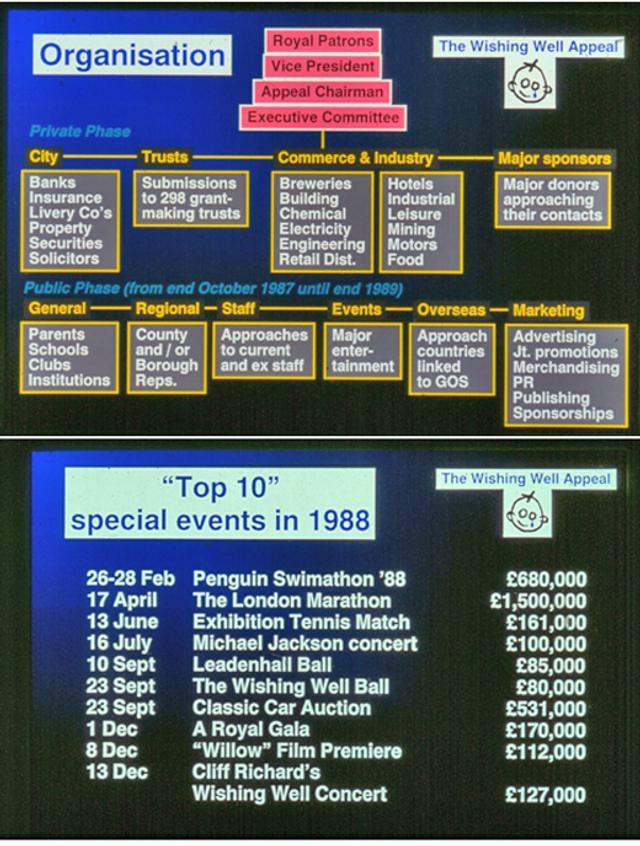
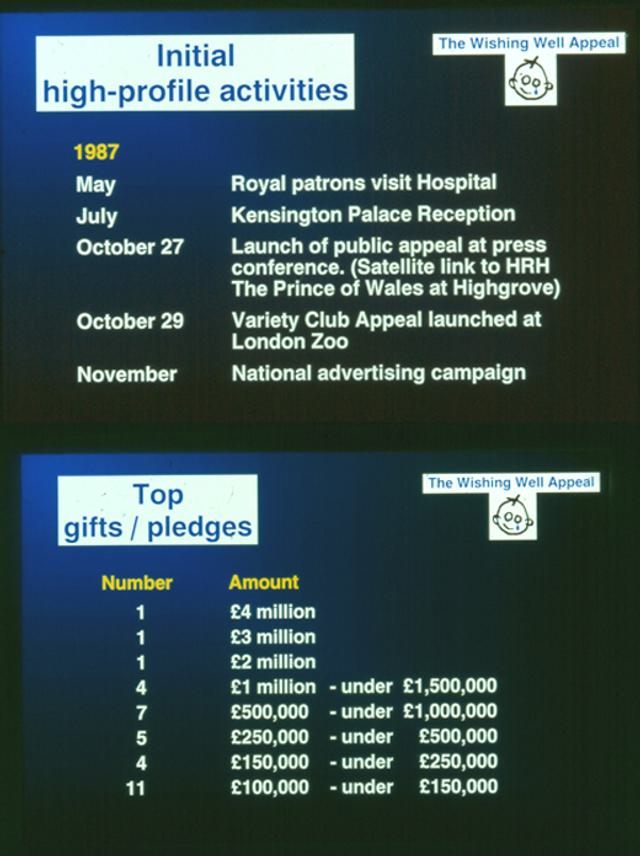
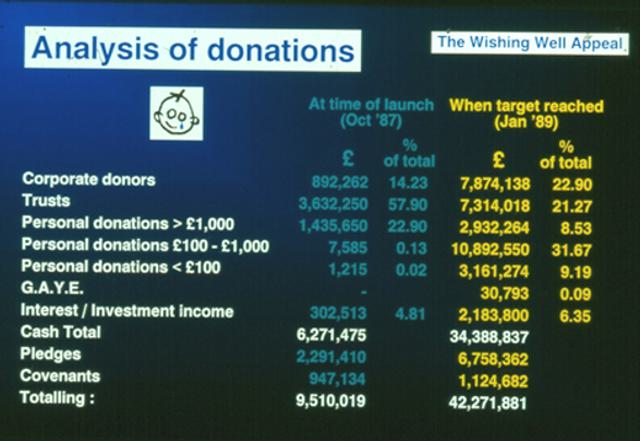 View original image
View original image



